Why you can trust Tom's Hardware
Comparison Products
First up, we have several QLC-based drives to compare to the AI818. These include the Crucial P3 and P3 Plus, the Solidigm P41 Plus, and the Corsair MP600 Core XT. A good stand-in TLC drive for the mid-range is the WD Black SN770. We’ve also included the newer Crucial T500 and PCIe 5.0 T700 to see how the AI818 fares against some of the latest — albeit more expensive — champions. Rounding out the list are our favorite PCIe 4.0 performers, the Solidigm P44 Pro, the Samsung 990 Pro, and the WD Black SN850X.
Trace Testing — 3DMark Storage Benchmark
Built for gamers, 3DMark’s Storage Benchmark focuses on real-world gaming performance. Each round in this benchmark stresses storage based on gaming activities including loading games, saving progress, installing game files, and recording gameplay video streams. Future gaming benchmarks will be DirectStorage-inclusive and we include details of that where possible.
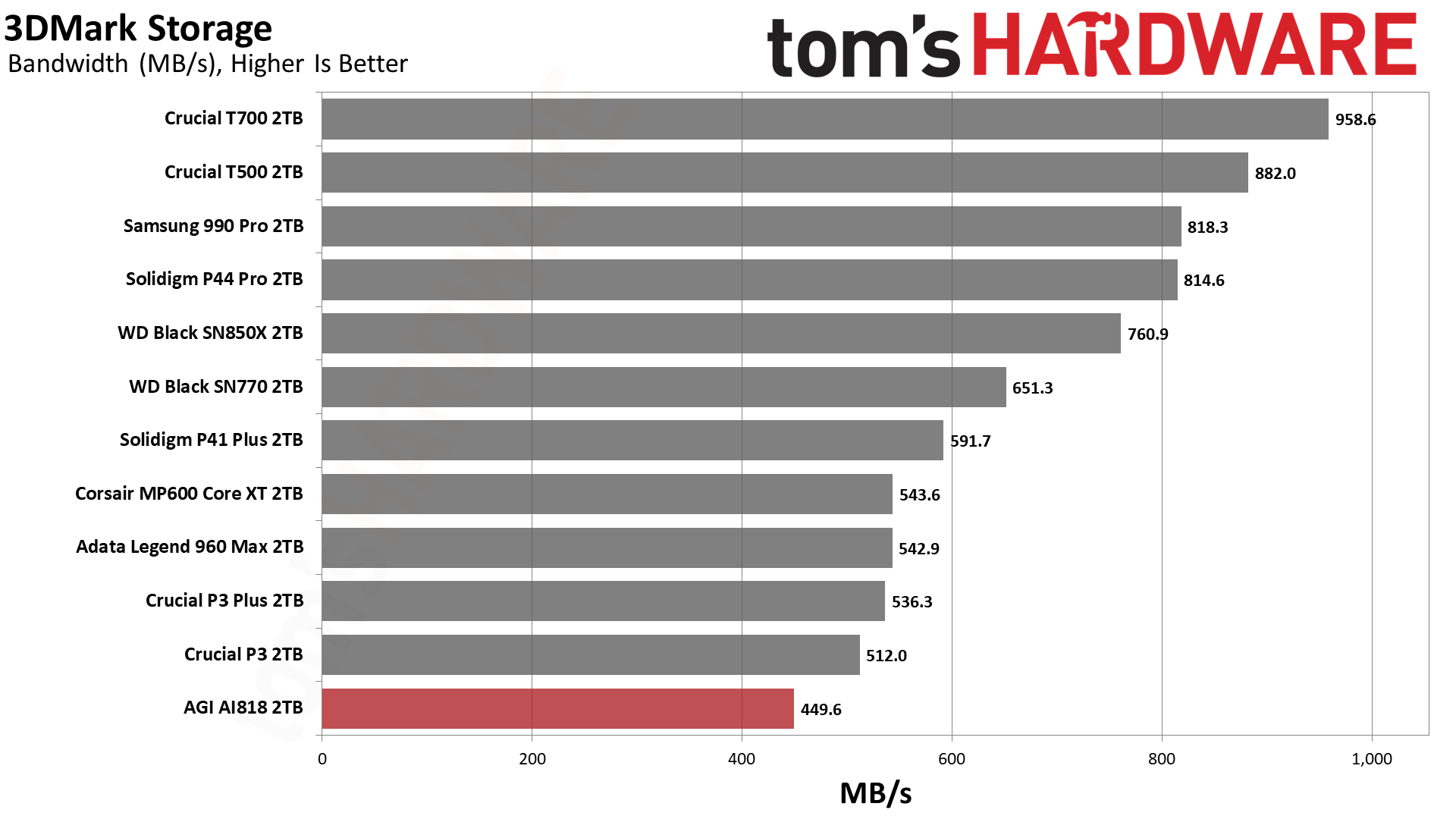
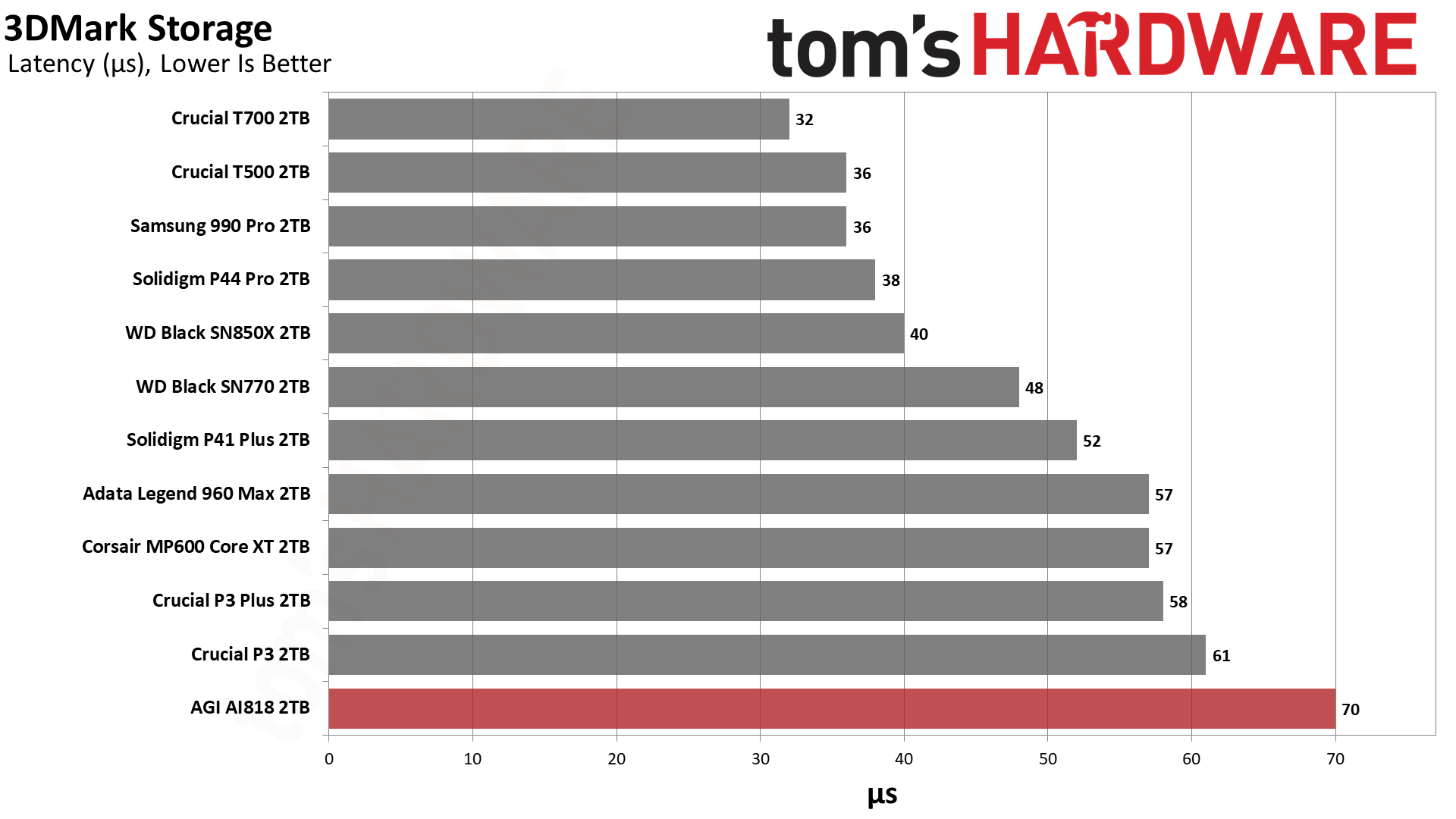

The AI818 performs poorly in 3DMark, though we weren’t expecting miracles. This drive would still work fine as a secondary drive dedicated to games, with perhaps slightly slower load times. We wouldn’t recommend it if you’re future-proofing for DirectStorage.
Trace Testing — PCMark 10 Storage Benchmark
PCMark 10 is a trace-based benchmark that uses a wide-ranging set of real-world traces from popular applications and everyday tasks to measure the performance of storage devices.



The AGI AI818 also does pretty poorly in PCMark 10. We wouldn’t recommend this drive for a primary or boot disk, though it can still get the job done if necessary.
Console Testing — PlayStation 5 Transfers
The PlayStation 5 is capable of taking one additional PCIe 4.0 or faster SSD for extra game storage, with some requirements. Launch models could not take 8TB drives but this limit has since been removed. While any PCIe 4.0 drive will work, Sony specifies drives that can deliver at least 5,500 MB/s of sequential read bandwidth are optimal.
The PS5 does not support the host memory buffer (HMB) feature but DRAM-less drives will still work. PCIe 5.0 SSDs with the latest firmware can work fine, though there's no advantage in putting such a drive in the PS5, especially as they may require additional cooling. Please see our Best PS5 SSDs article for more information.
Our testing utilizes the PS5’s internal storage test and manual read/write tests with over 192GB of data both from and to the internal storage. Throttling is prevented where possible to see how each drive operates under ideal conditions.

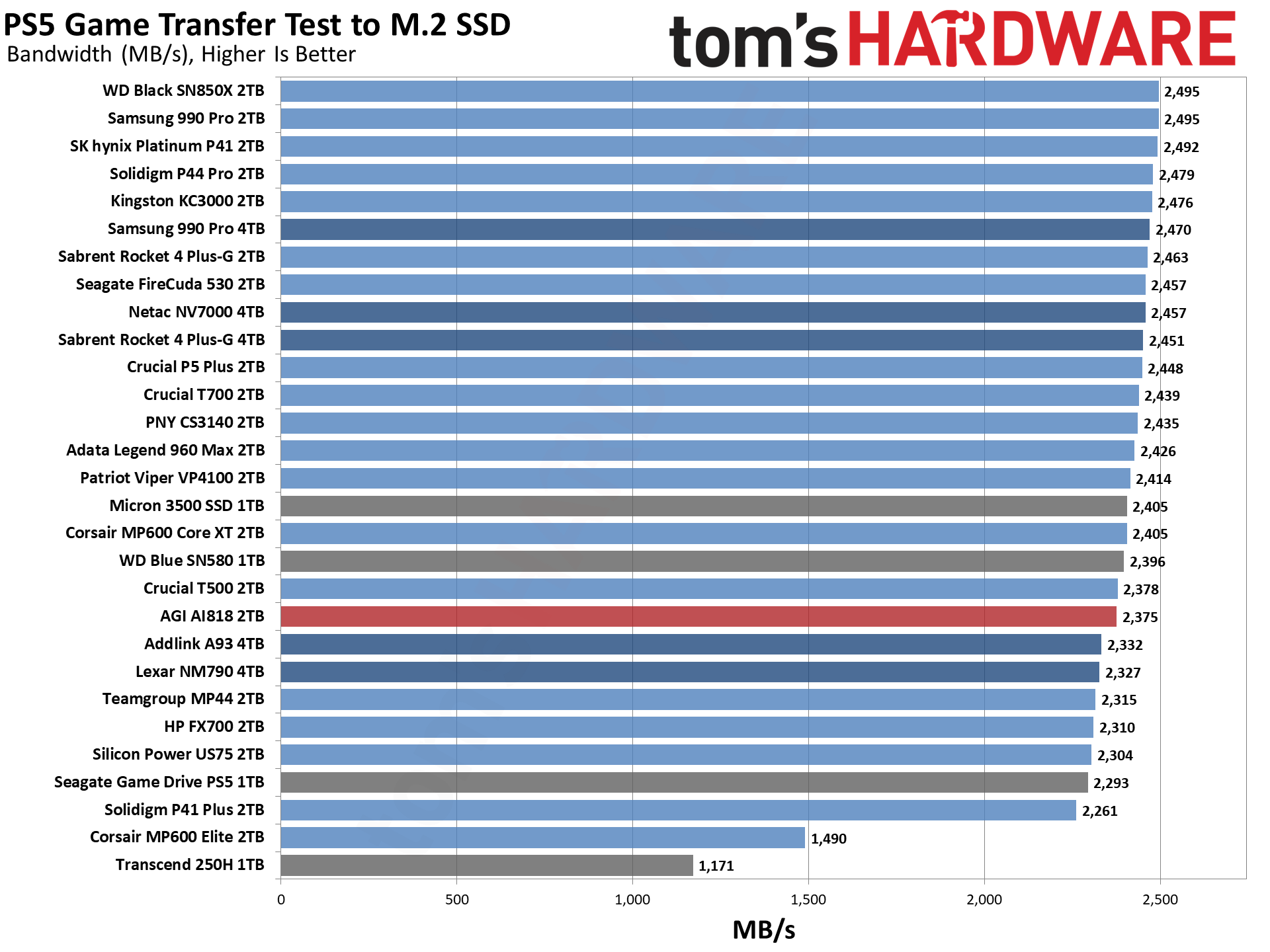

One of the best places to use the AGI818 is probably in a PlayStation 5. Its performance is adequate to give a relatively normal experience. We would recommend installing a heatsink if possible, though the Sabrent PS5 heatsink is a great and inexpensive option.
Get Tom's Hardware's best news and in-depth reviews, straight to your inbox.
Transfer Rates — DiskBench
We use the DiskBench storage benchmarking tool to test file transfer performance with a custom, 50GB dataset. We copy 31,227 files of various types, such as pictures, PDFs, and videos to a new folder and then follow-up with a reading test of a newly-written 6.5GB zip file. This is a real world type workload that fits into the cache of most drives.

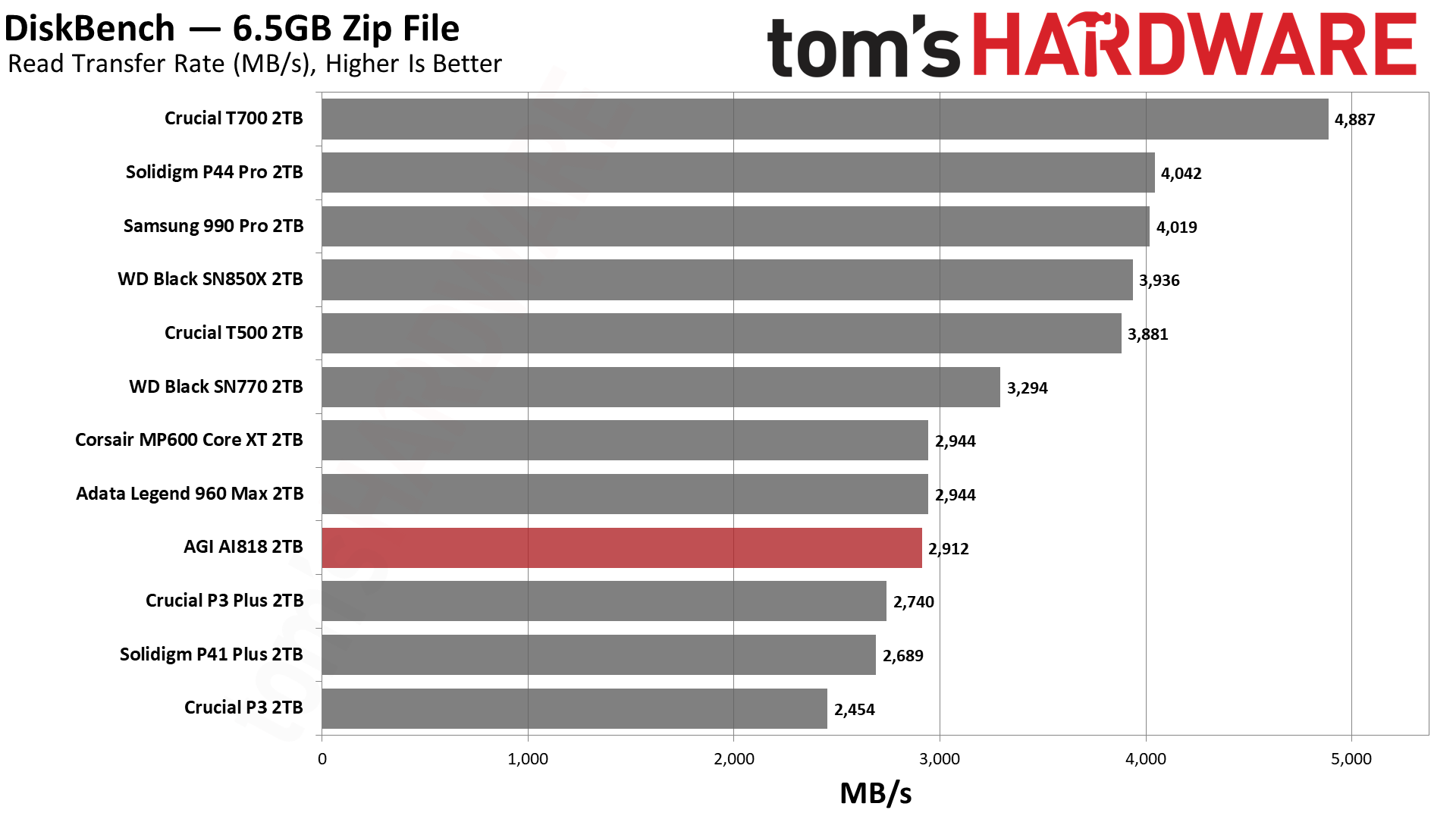
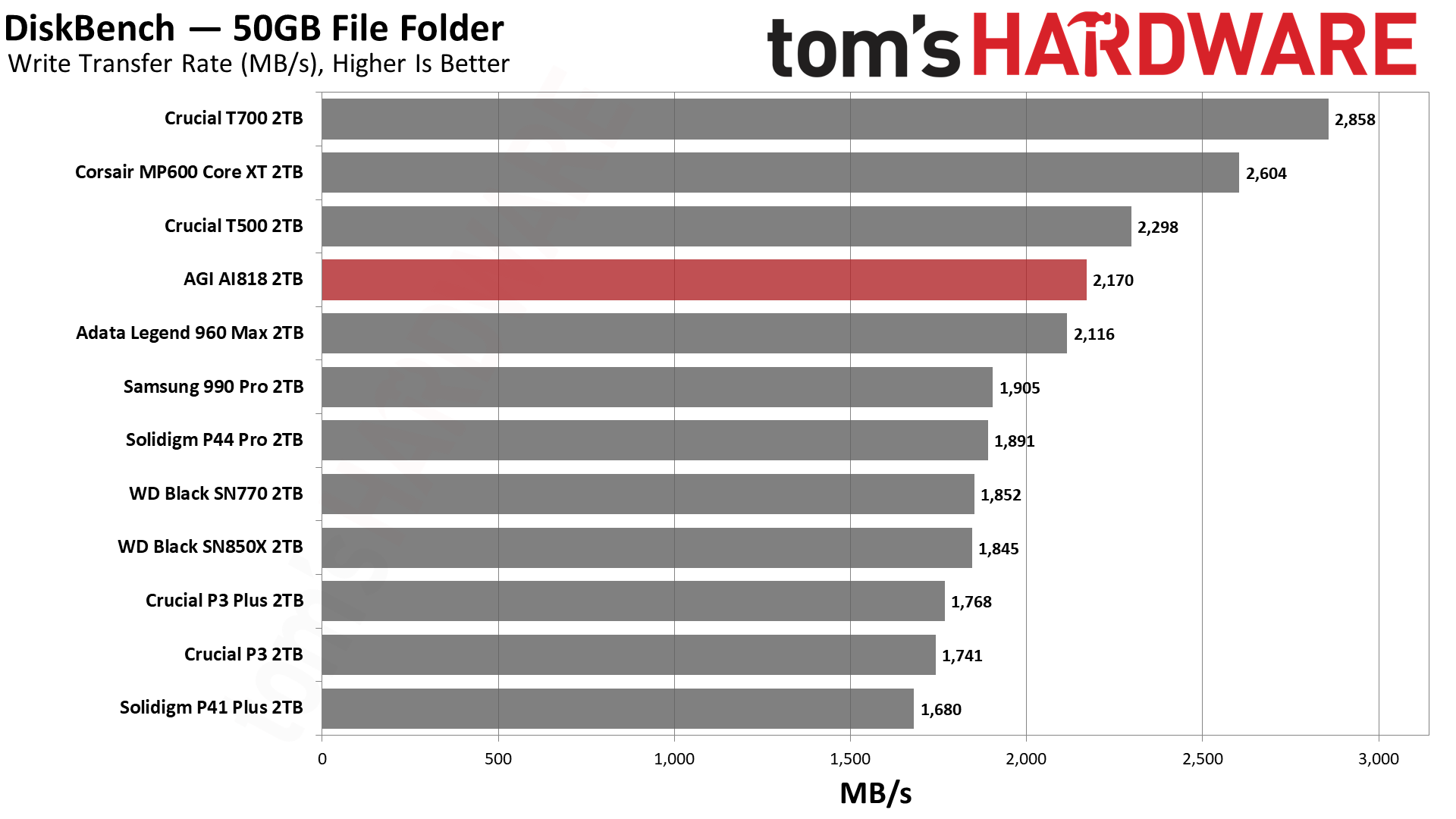
QLC is not the best when you’re shooting for better transfer speeds. This is true of the P3, P3 Plus, and P41 Plus, and it is also true of the AI818. Its performance is possibly worse because of the controller being used. Its performance is still better than SATA and older NVMe drives, though.
Synthetic Testing — ATTO / CrystalDiskMark
ATTO and CrystalDiskMark (CDM) are free and easy-to-use storage benchmarking tools that SSD vendors commonly use to assign performance specifications to their products. Both of these tools give us insight into how each device handles different file sizes and at different queue depths.
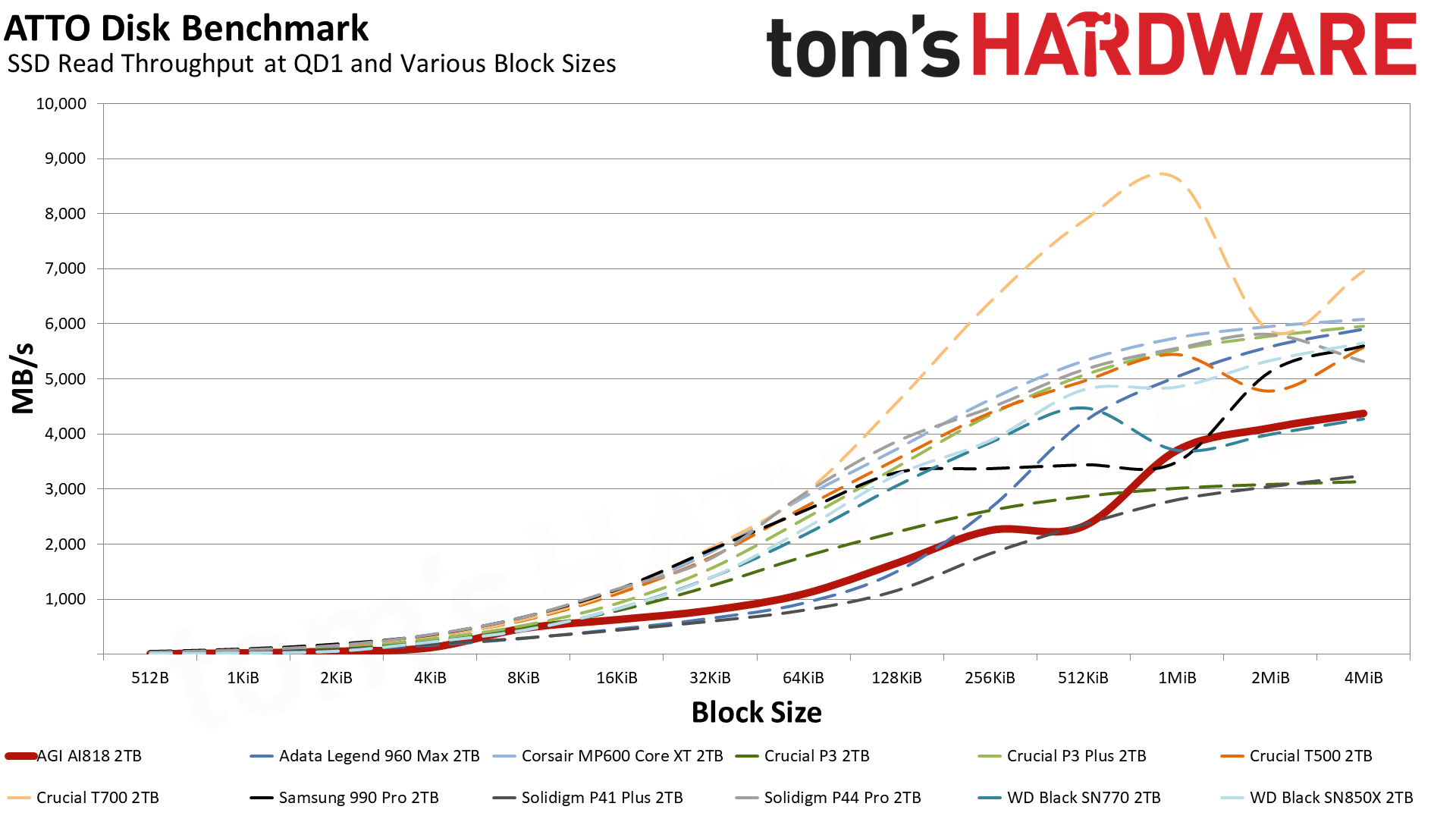
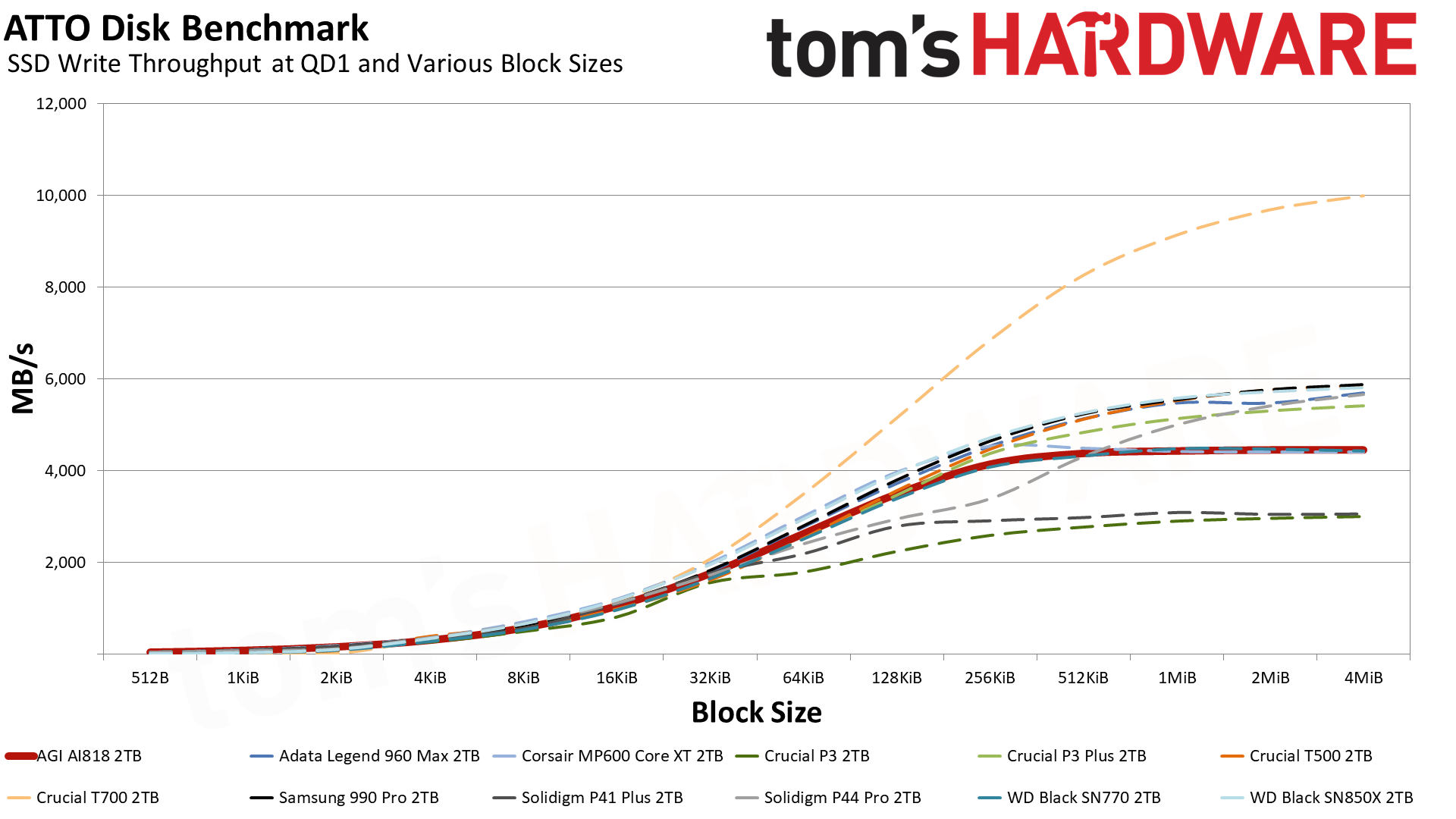

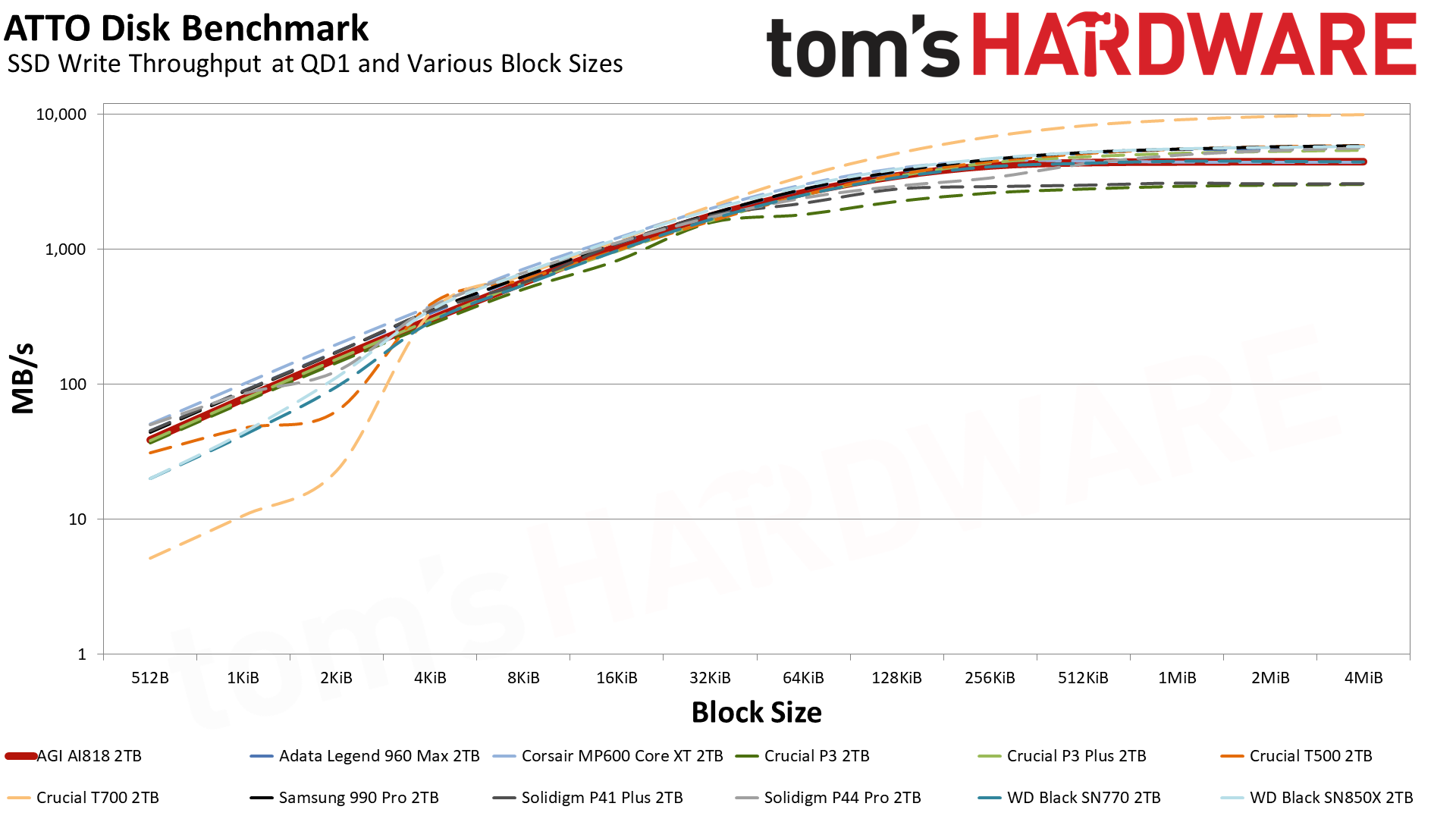

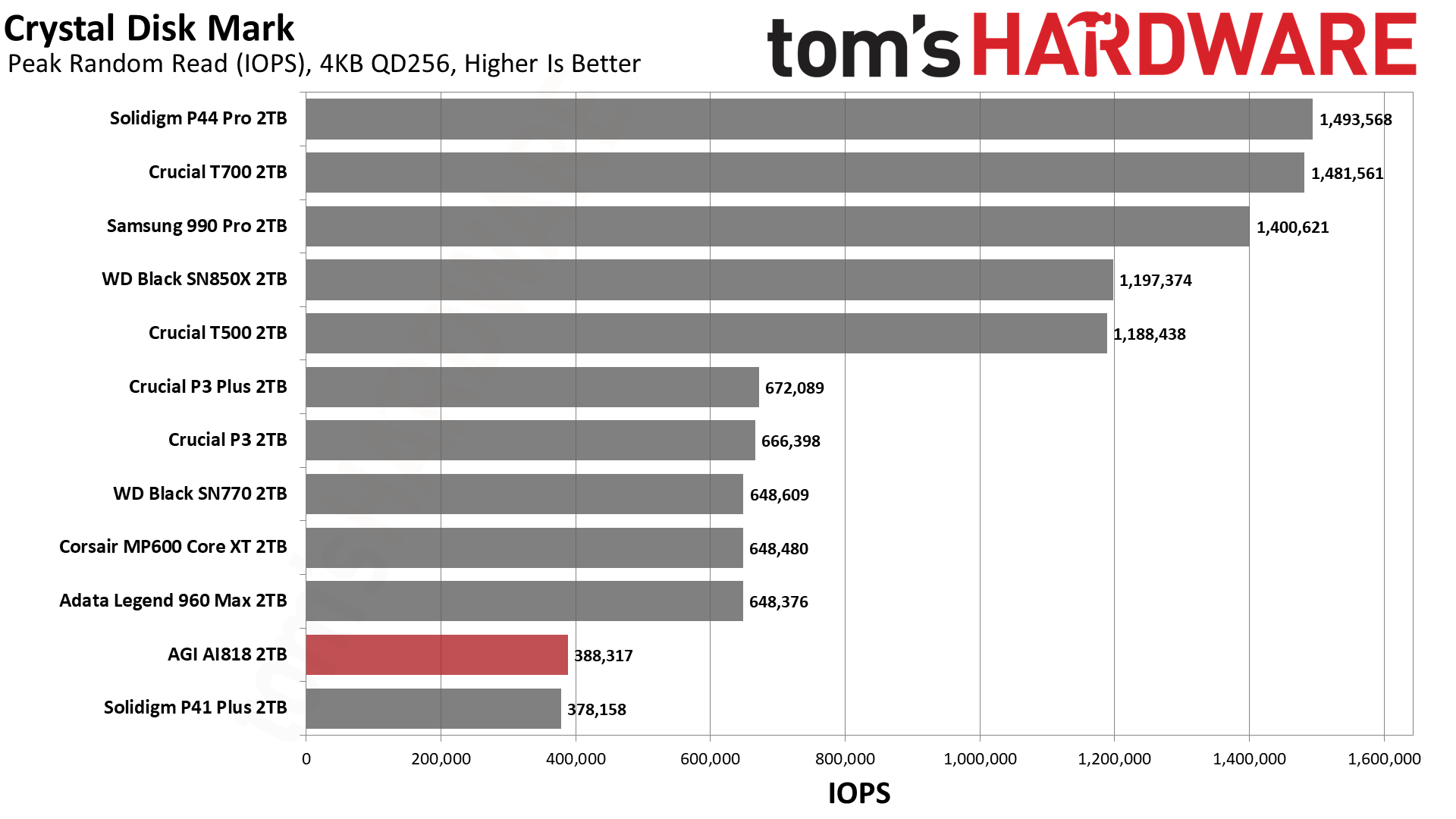
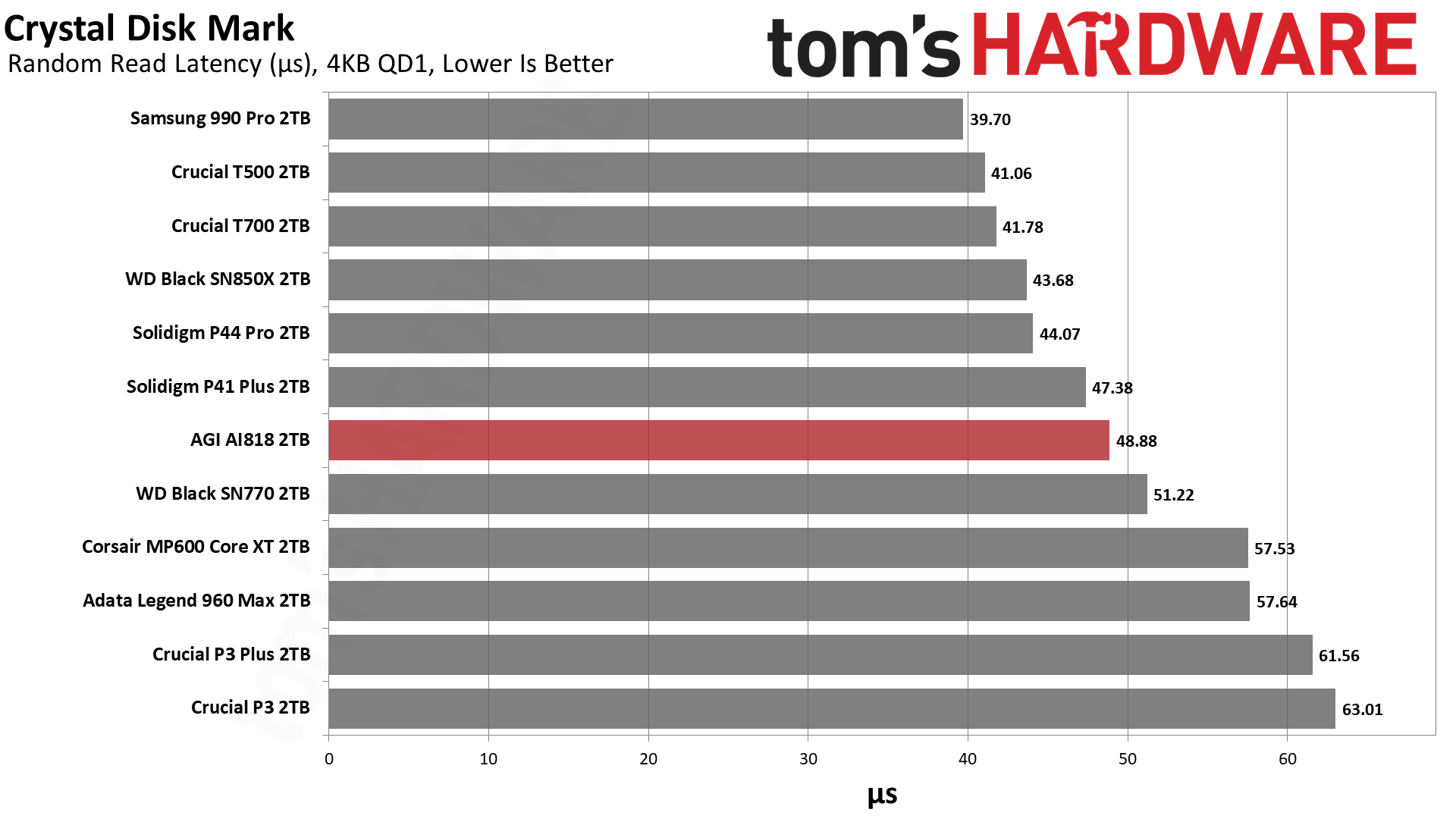
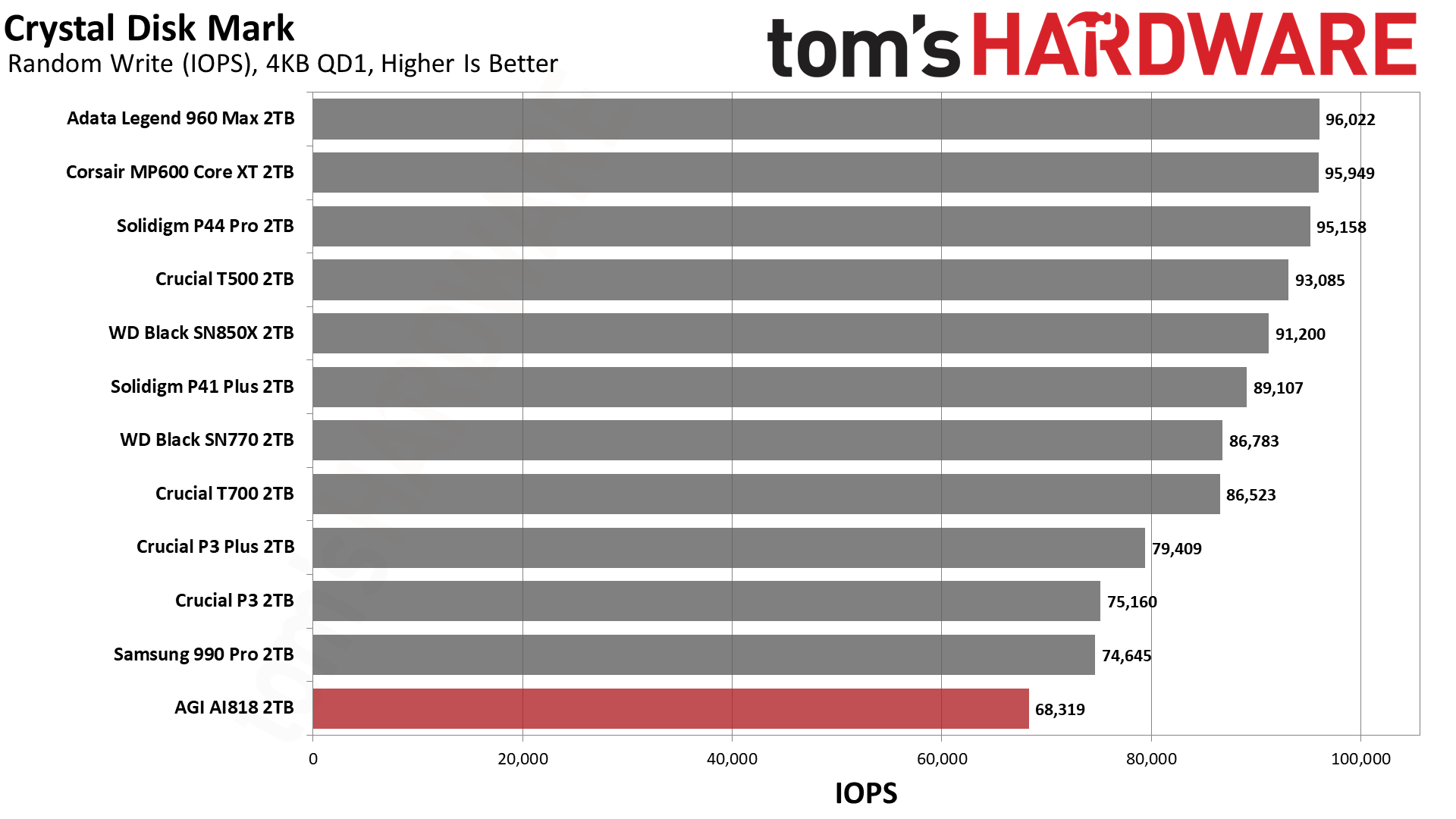

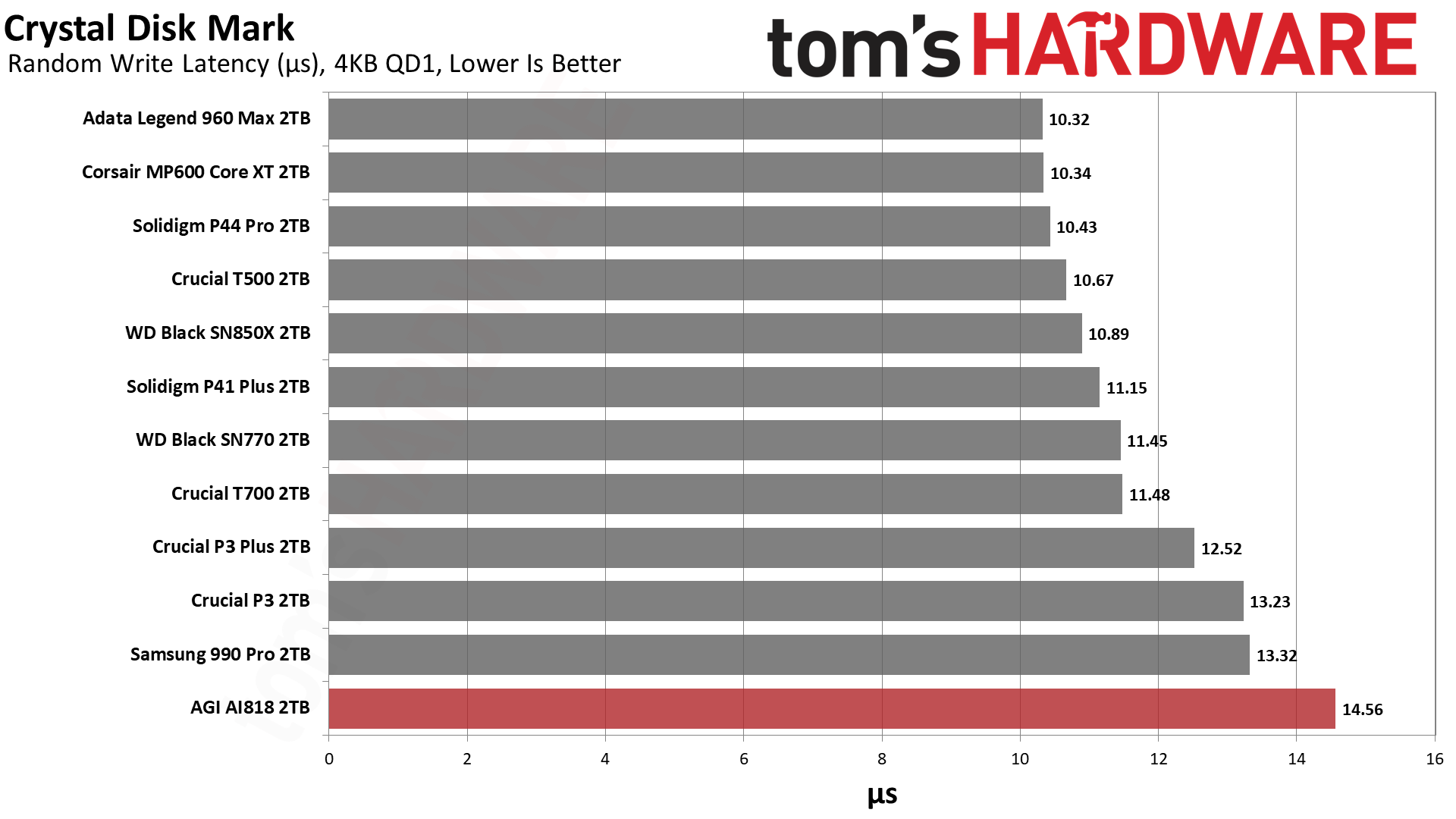
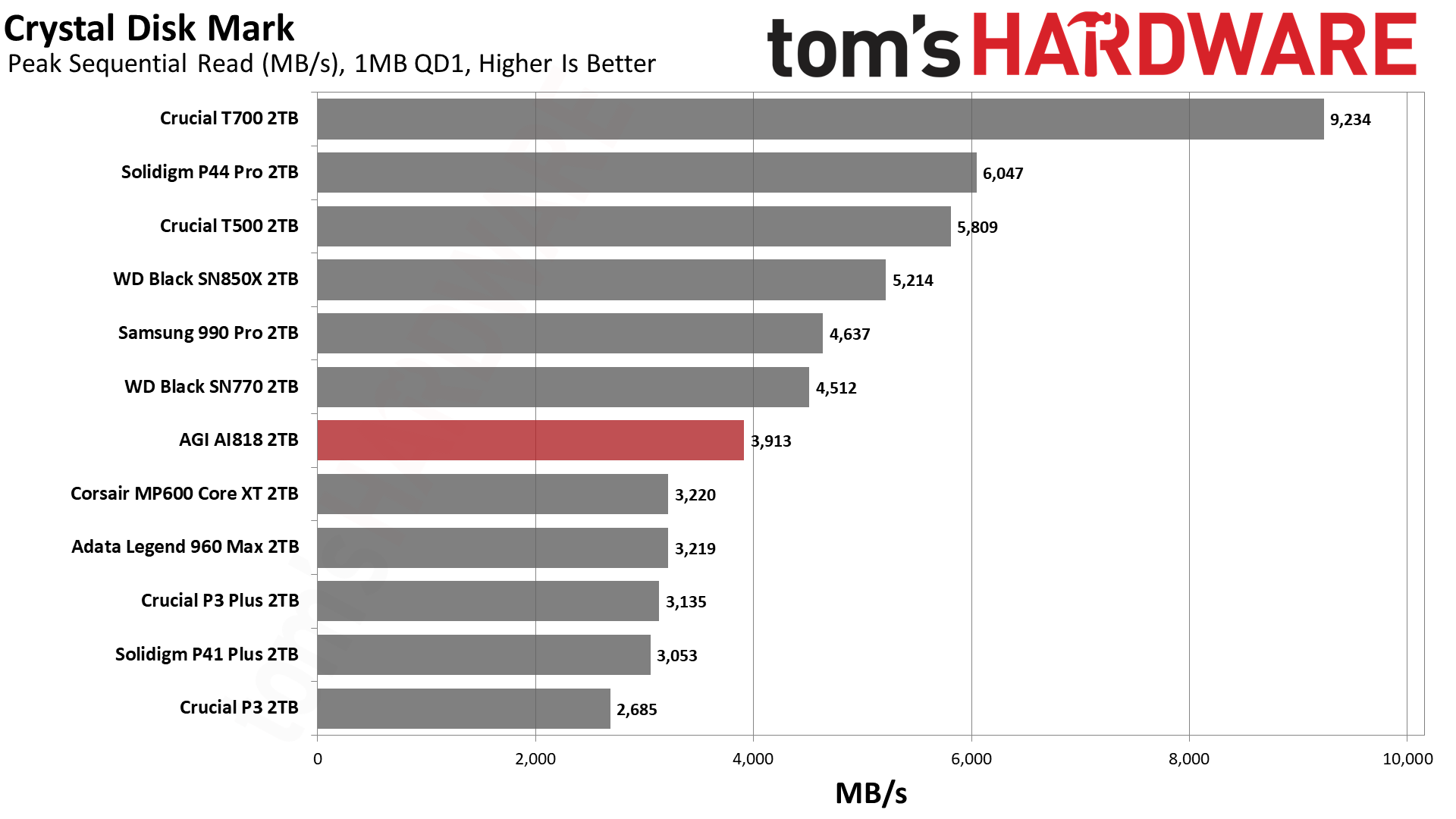
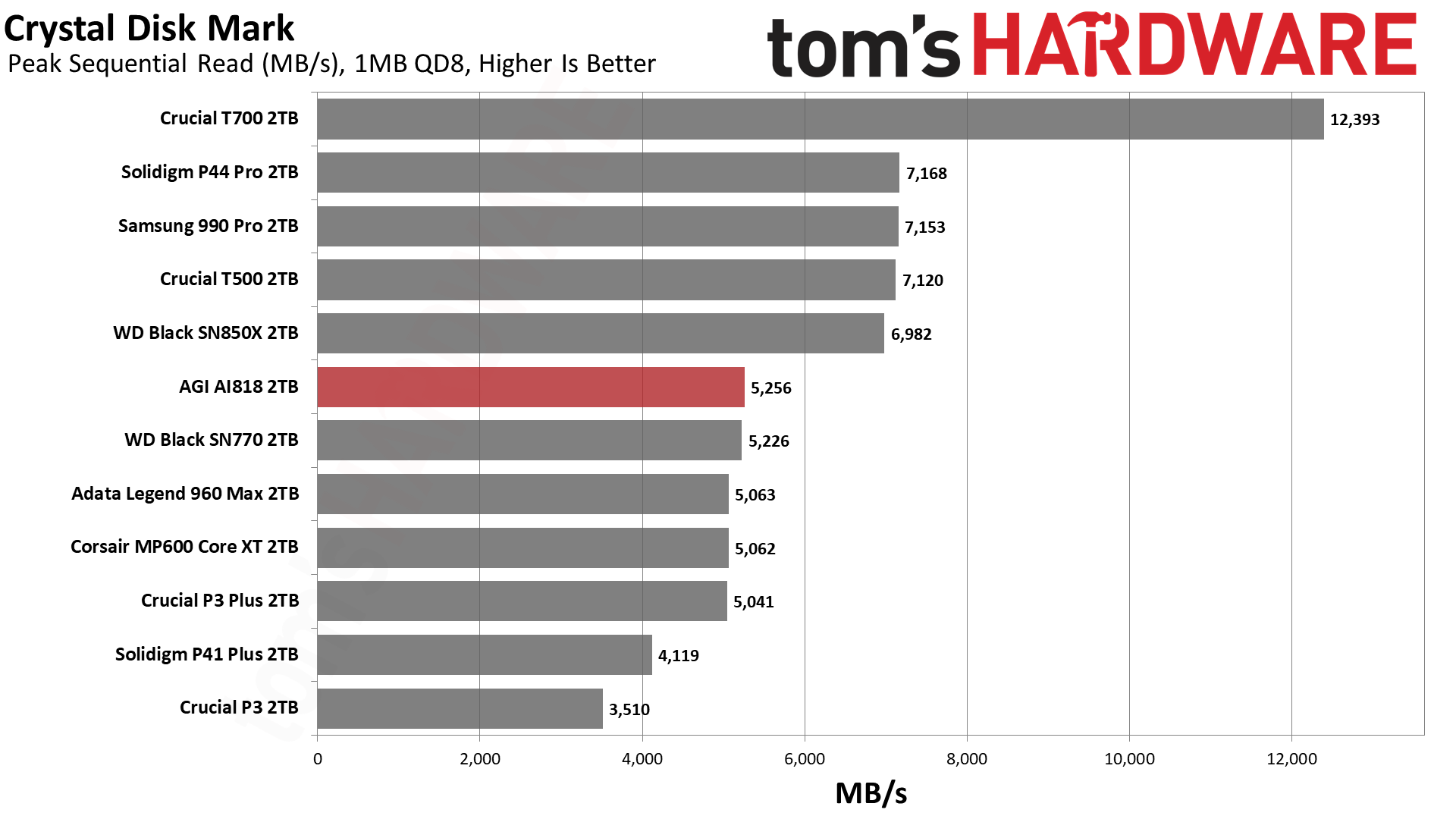

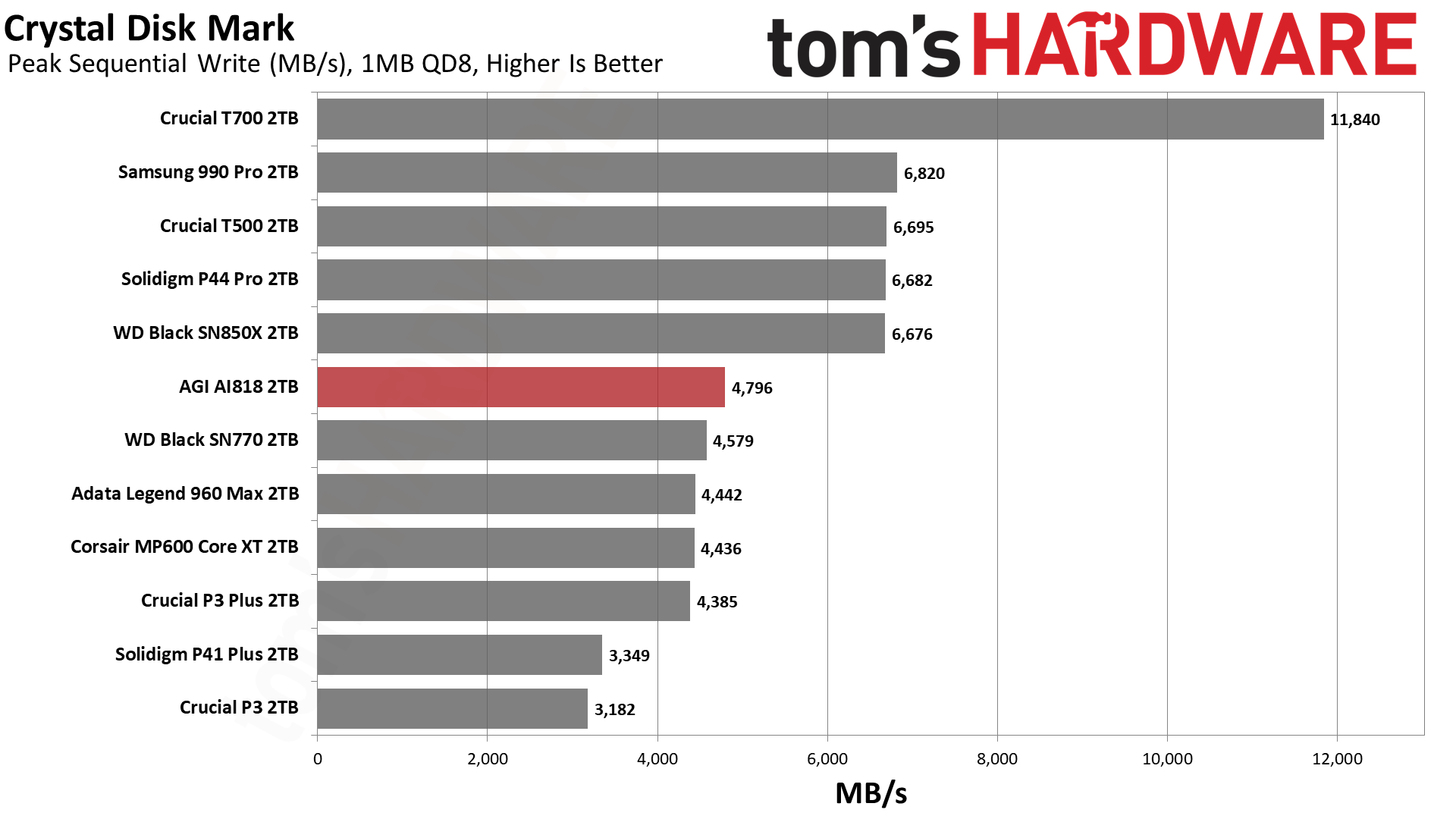
ATTO sequential performance is smooth with writes, but less consistent with reads. There’s a notable drop around the 512KiB block size, possibly a facet of this controller when paired with this flash given the superpage size in an eight-channel configuration. Performance as a whole here is weak, but it can push more bandwidth than a PCIe 3.0 drive like the P3. Sequential performance in CDM is fair and certainly good enough for a budget drive.
Random performance is a different story as 4KB latencies are relatively high. Reads aren’t that bad, but writes have a long latency and we know this flash can do much better. It’s possible this controller isn’t quite up to the level of the competition. It feels last-generation in many ways, but a fair point to make is that a budget drive purchased just to add capacity doesn’t need much more than even baseline PCIe 3.0 technology.
Sustained Write Performance and Cache Recovery
Official write specifications are only part of the performance picture. Most SSDs implement a write cache, which is a fast area of (usually) pseudo-SLC programmed flash that absorbs incoming data. Sustained write speeds can suffer tremendously once the workload spills outside of the cache and into the "native" TLC or QLC flash.
We use Iometer to hammer the SSD with sequential writes for 15 minutes (usually longer) to measure both the size of the write cache and performance after the cache is saturated. We also monitor cache recovery via multiple idle rounds. This process shows the performance of the drive in various states as well as the steady state write performance.
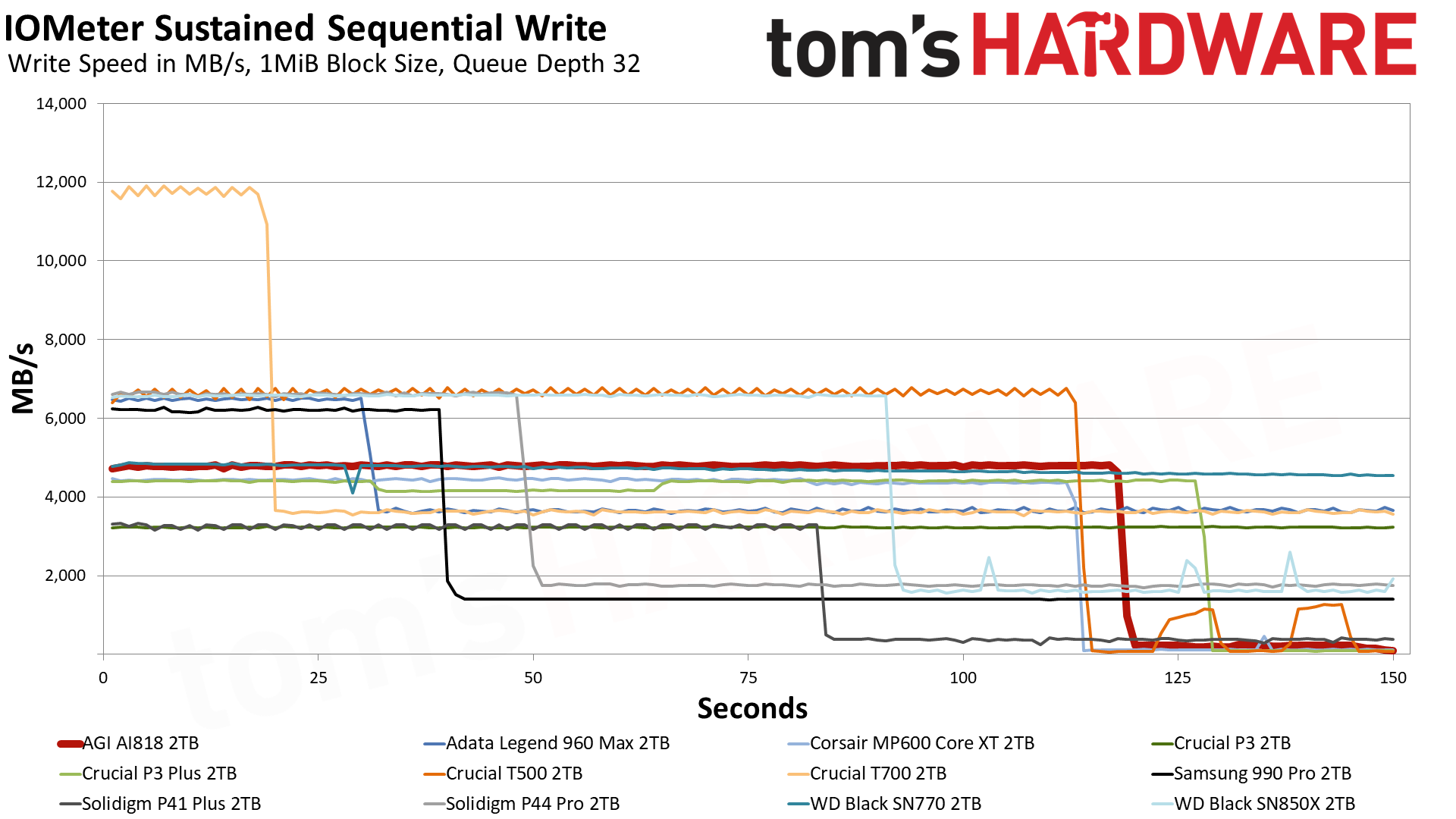
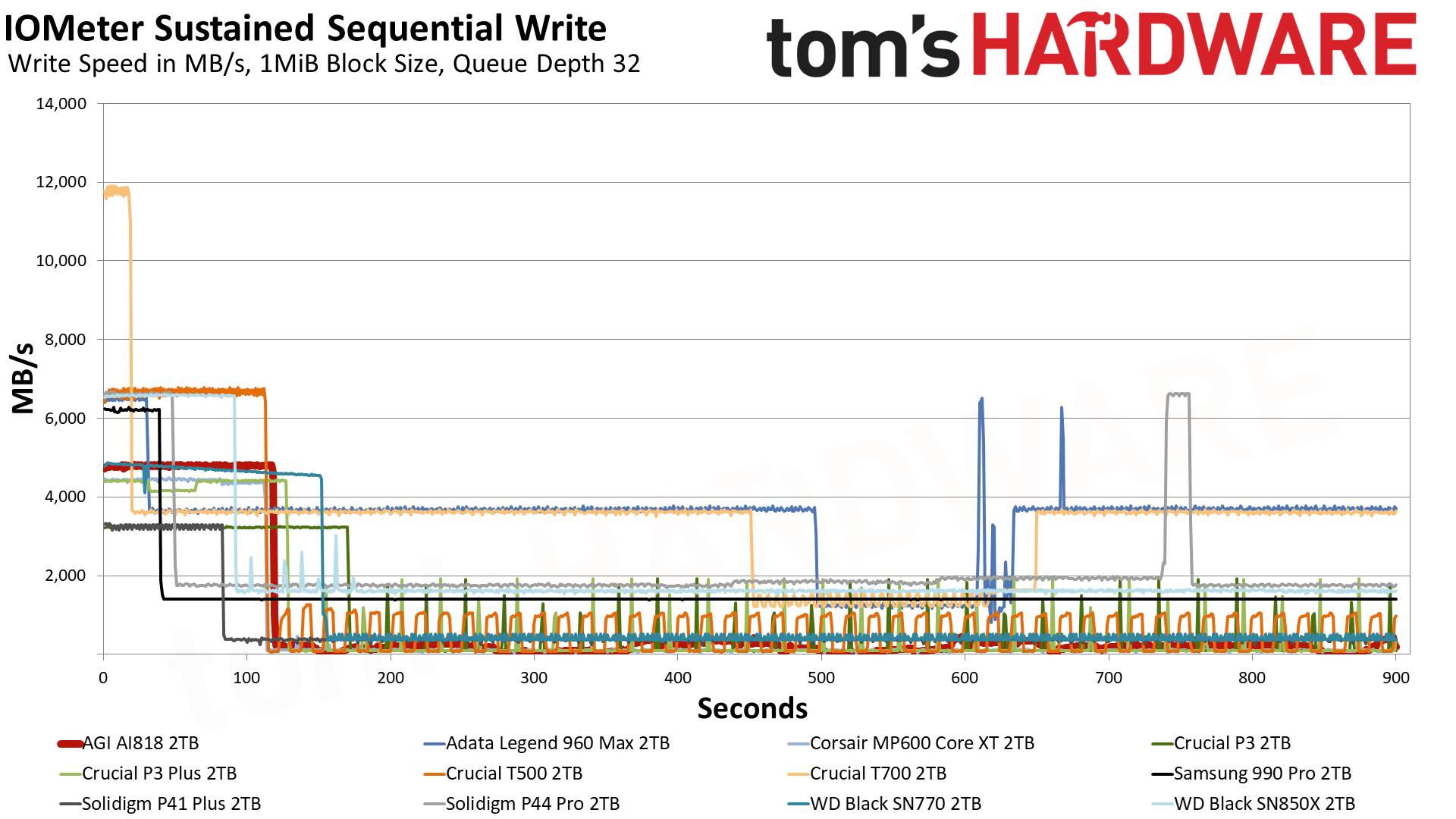
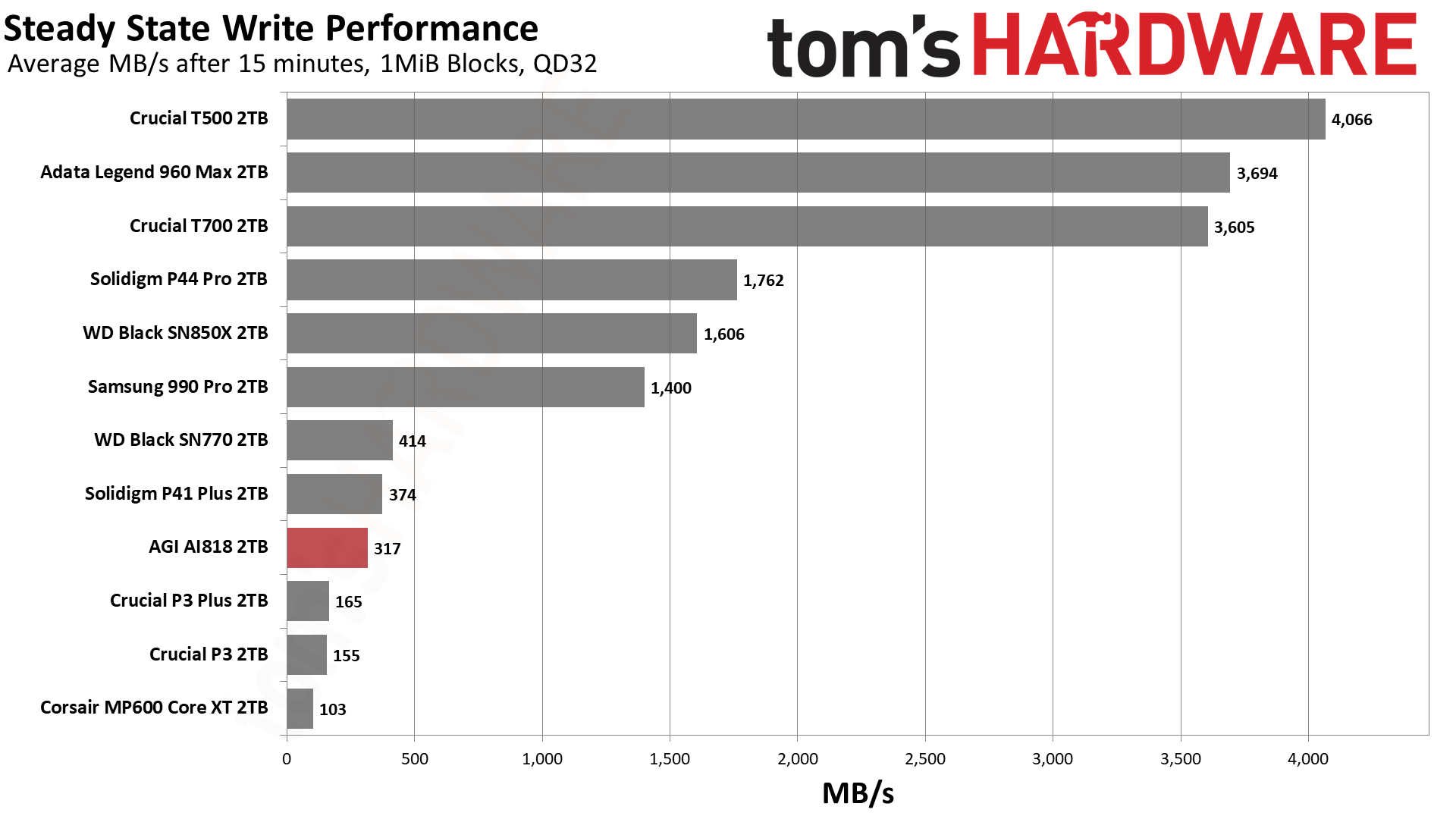
We never expect much from QLC when it comes to sustained writes, so we’re not too disappointed here. The 2TB AI818 writes in pSLC mode at 4.8 GB/s for about 118 seconds. This means the cache spans the entire extent of the drive’s flash, so it will be about one-fourth the capacity of the drive. The drive then hits a folding QLC state at over 200 MB/s.
This isn’t too terrible, all things considered. As the cache is large and dynamic, recovery is attempted rapidly and eventually produces a steady state write speed over 300 MB/s. While this is weaker than what we see with hybrid cache drives with this flash — like the 670p or P41 Plus — it’s better than others with comparable QLC, like the P3 and P3 Plus. The AI818’s eight-channel controller potentially helps here when given enough flash to work with at 2TB.
Power Consumption and Temperature
We use the Quarch HD Programmable Power Module to gain a deeper understanding of power characteristics. Idle power consumption is an important aspect to consider, especially if you're looking for a laptop upgrade as even the best ultrabooks can have mediocre stock storage. Desktops may be more performance-oriented with less support for power-saving features, so we show the worst-case.
Some SSDs can consume watts of power at idle while better-suited ones sip just milliwatts. Average workload power consumption and max consumption are two other aspects of power consumption but performance-per-watt, or efficiency, is more important. A drive might consume more power during any given workload, but accomplishing a task faster allows the drive to drop into an idle state more quickly, ultimately saving energy.
For temperature recording we currently poll the drive’s primary composite sensor during testing with a 21C ambient. Our testing is rigorous enough to heat the drive to a realistic ceiling temperature.
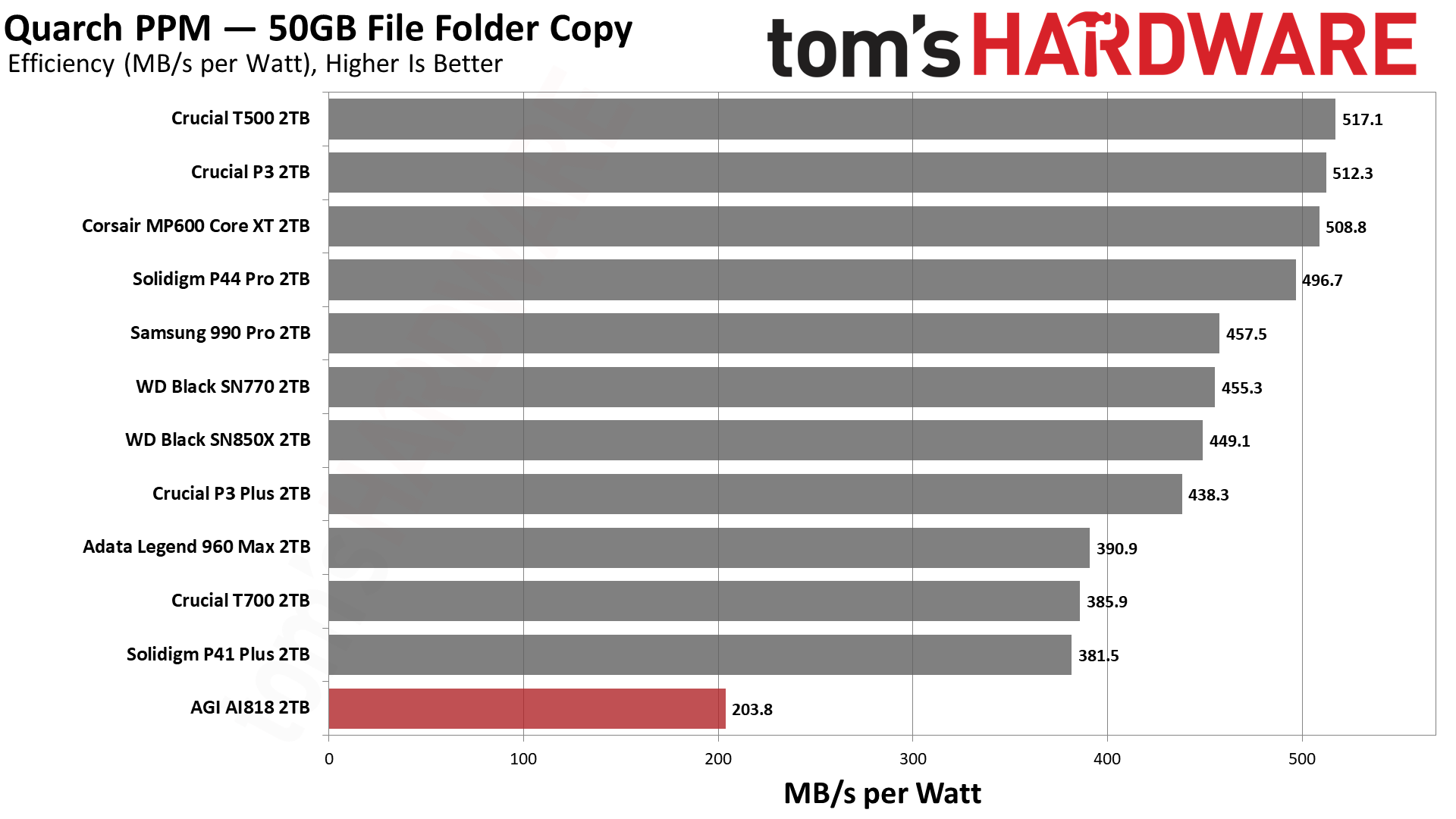
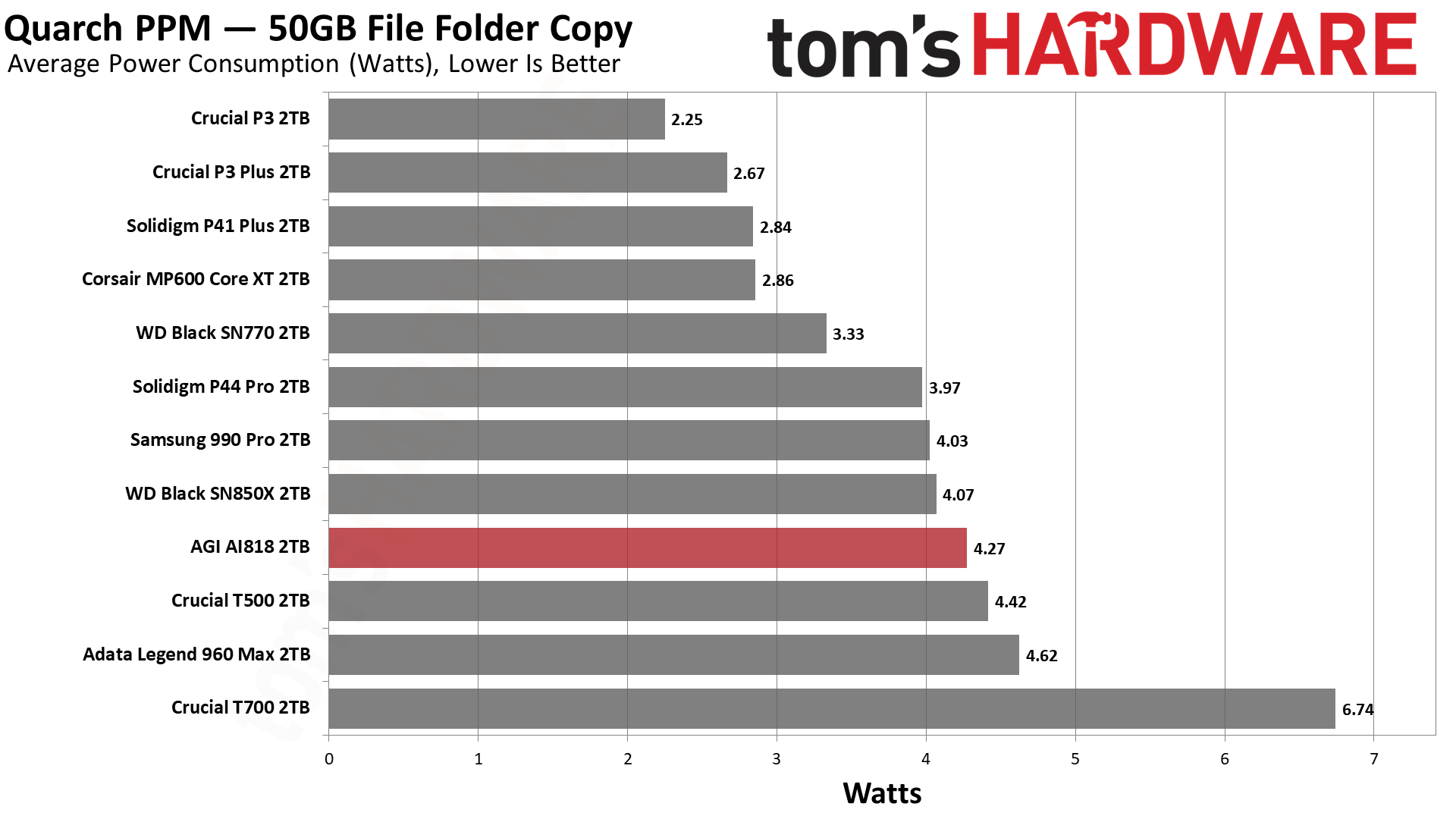

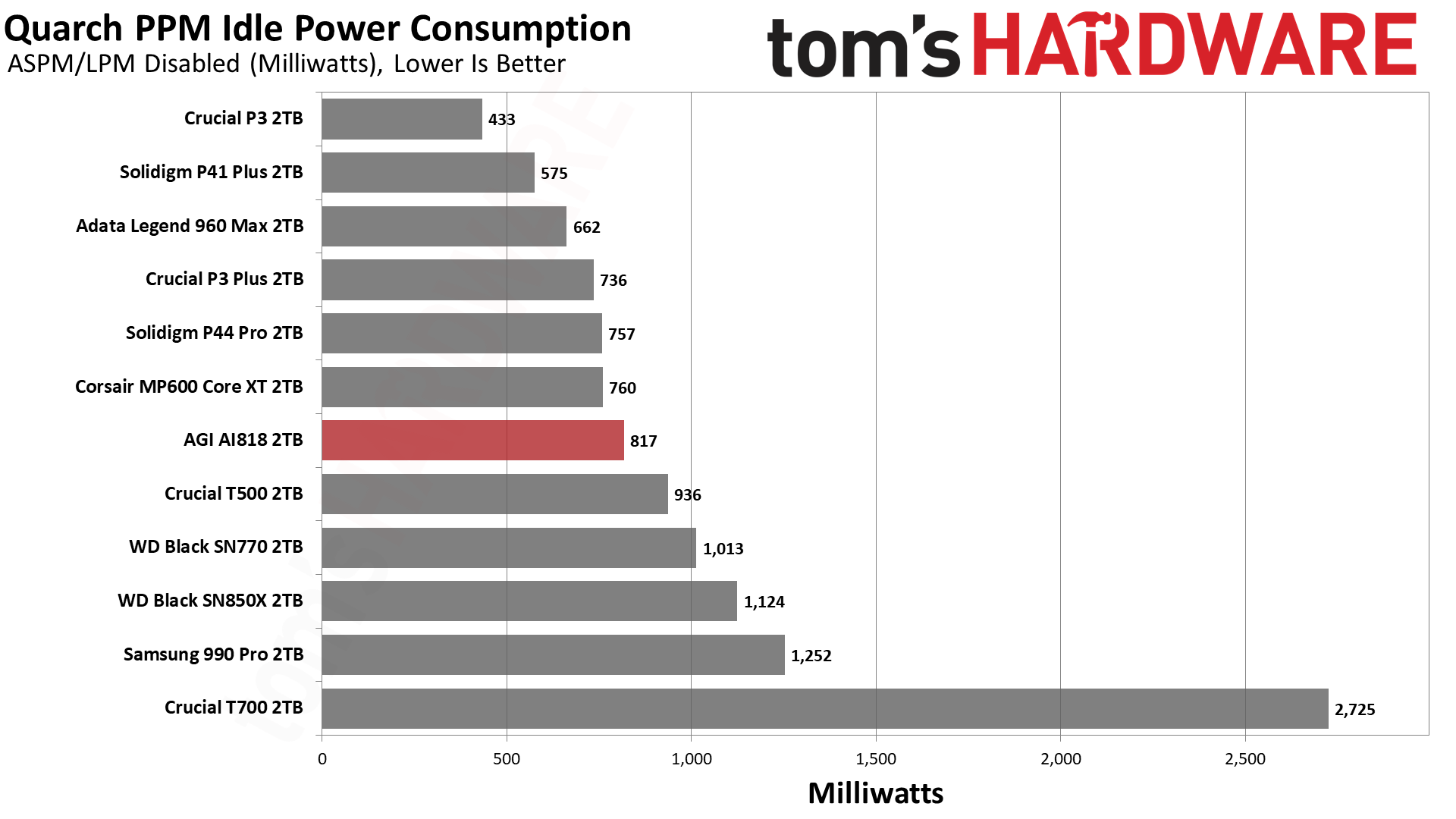
As we expected above, the use of an eight-channel controller with potentially an older design is going to hurt when it comes to power consumption and thermal output. The AI818 is quite inefficient, very much feeling like a standard PCIe 3.0 drive. We wouldn’t recommend it for laptops for this reason, but for light desktop use or for us in a PS5 it should be fine.
The thermals also prevent it from being a good laptop candidate. We hit 80C during testing, which is not as bad as it sounds as this drive’s sensor pulls from the controller which doesn’t throttle until 100C. Still, we would recommend a heatsink if possible, even if it’s just an M.2 covering from your motherboard.
Test Bench and Testing Notes
| CPU | Intel Core i9-12900K |
| Motherboard | Asus ROG Maximus Z790 Hero |
| Memory | 2x16GB G.Skill DDR5-5600 CL28 |
| Graphics | Intel Iris Xe UHD Graphics 770 |
| CPU Cooling | Enermax Aquafusion 240 |
| Case | Cooler Master TD500 Mesh V2 |
| Power Supply | Cooler Master V850 i Gold |
| OS Storage | Sabrent Rocket 4 Plus 2TB |
| Operating System | Windows 11 Pro |
We use an Alder Lake platform with most background applications such as indexing, Windows updates, and anti-virus disabled in the OS to reduce run-to-run variability. Each SSD is prefilled to 50% capacity and tested as a secondary device. Unless noted, we use active cooling for all SSDs.
Bottom Line
We were tempted to give the AGI AI818 a lower score, but then we remembered that other drives in the ultra-budget category include the Kingston NV2. Drives like that built on DRAM-less PCIe 3.0 technology, or PCIe 4.0 technology that is effectively PCIe 3.0, still exist. The AI818 actually offers a little bit of uplift over those due to its eight-channel controller. That has the downside of making the drive less efficient with more heat output, but that’s fine for a secondary or gaming SSD. The extra speed also puts it over the line for the PS5, but we wouldn’t recommend using this in a laptop.
Performance results are all over the place as sometimes the AI818 actually outperforms other QLC drives in its class like the P3 Plus and MP600 Core XT. It’s surprisingly not so awful in sustained writes, either. On the other hand, its marks in other areas make it tough to swallow if you want something cheap as your primary storage device. There’s an argument to be made that it still beats many PCIe 3.0 options, which is true, but you’re only looking at this class of drive as a last resort. This might play to its favor for older PCIe 3.0 systems, too.
As such, it’s best to position this drive on your list around cost. If it’s the least expensive drive you can find, or in that ballpark, and you need something to upgrade an old machine or only need something basic for a secondary gaming drive, then this is satisfactory. It could run fine without any modification, but a heatsink might be desirable in warmer environments, so that may have to be added to its cost as a factor. If you’re already looking at drives like the NV2, which are usually QLC at 2TB, then the AI818 is certainly a competitor. Its eight-channel controller cuts both ways but at least it uses decent QLC. Given current retail pricing, however, we'd generally look at the Crucial P3 Plus for a budget option.
MORE: Best SSDs
MORE: Best External SSDs and Hard Drives
MORE: How We Test HDDs And SSDs
MORE: All SSD Content

Shane Downing is a Freelance Reviewer for Tom’s Hardware US, covering consumer storage hardware.
